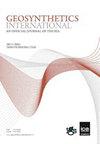Behavior of back-to-back mechanically stabilized earth walls as railway embankments
IF 3.3
2区 工程技术
Q2 ENGINEERING, GEOLOGICAL
引用次数: 0
Abstract
Twelves physical model tests were carried out to investigate the role of the type and arrangement of reinforcements on the behavior of back-to-back mechanically stabilized earth walls (BBMSEWs) supporting railway tracks. Six metal-strip reinforced BBMSEW models and six geogrid reinforced models were prepared with different reinforcement arrangements and then were vertically loaded to failure using wooden railway sleepers. The findings indicated that the reinforcement stiffness played a more prominent role in improving the bearing capacity than the pull-out capacity. The connection of two opposing walls with continuous reinforcements and the complete separation of them from each other were found to be the best and worst reinforcement arrangements. respectively, for improving the bearing capacity and reducing wall deformation in BBMSEWs. The respective use of these two arrangements mobilized the maximum and minimum forces in the reinforcements. Moreover, the creation of a proper connection between the opposing walls using continuous inextensible reinforcements or those with a sufficient overlap lengths were found to be efficient solutions to preventing the propagation of a failure plane across the back-to-back MSE walls.作为铁路路堤的背靠背机械稳定土墙的特性
为了研究加固材料的类型和布置对支撑铁路轨道的背靠背机械加固土墙(BBMSEW)行为的影响,我们进行了十二次物理模型试验。采用不同的加固方式制作了六种金属条加固土墙模型和六种土工格栅加固土墙模型,然后使用木质铁路枕木对其进行垂直加载至破坏。研究结果表明,加固刚度在提高承载能力方面的作用比抗拔能力更为显著。在提高 BBMSEW 的承载能力和减少墙体变形方面,将两面对立的墙体用连续的钢筋连接起来和将它们完全分开分别是最好和最差的钢筋布置。这两种布置方式分别能使钢筋受力最大和最小。此外,使用连续的不可延伸钢筋或具有足够重叠长度的钢筋在对立墙体之间建立适当的连接,被认为是防止破坏面在背靠背 MSE 墙体上传播的有效解决方案。
本文章由计算机程序翻译,如有差异,请以英文原文为准。
求助全文
约1分钟内获得全文
求助全文
来源期刊

Geosynthetics International
ENGINEERING, GEOLOGICAL-GEOSCIENCES, MULTIDISCIPLINARY
CiteScore
6.90
自引率
20.00%
发文量
91
审稿时长
>12 weeks
期刊介绍:
An online only, rapid publication journal, Geosynthetics International – an official journal of the International Geosynthetics Society (IGS) – publishes the best information on current geosynthetics technology in research, design innovation, new materials and construction practice.
Topics covered
The whole of geosynthetic materials (including natural fibre products) such as research, behaviour, performance analysis, testing, design, construction methods, case histories and field experience. Geosynthetics International is received by all members of the IGS as part of their membership, and is published in e-only format six times a year.
 求助内容:
求助内容: 应助结果提醒方式:
应助结果提醒方式:


